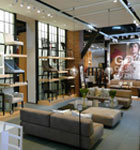The 16,200-square-foot, bilevel West Elm store on Bay Street in Emeryville, California, is a single-story, steel-frame building—with a mezzanine—built on 33-foot-deep mud and seven-foot-deep fill, which forced the contractor to drive a total of 51 16-inch-diameter, augered cast-in-place piles 64 feet deep. That’s a lot of numbers to keep track of, not to mention understanding what they mean. Designed by McCall Design Group, the West Elm store’s many eco-friendly elements—including a green roof designed by Rana Creek Living Architecture, best known for the LEED Platinum-certified California Academy of Sciences—presented challenges for the design and construction team. Alex Fisher, vice president of business development at Fisher Development, details some of the requirements involved in creating the retail store that he says was “built from the ground up using state-of-the-art, green building practices.”
 Build Without a Staging Area
Build Without a Staging Area
According to Fisher, the site—a narrow wedge of land sandwiched between a parking structure and a frontage road—had no staging area. This presented a number of challenges. “There was no lay-down area and no place to park trucks, making it logistically a very tough project,” Fisher says. “Real estate was at such a premium [that] we actually staged the job on the site and built the building around our materials. We also stored materials on the roof when [it] was complete. We also had to reduce waste to virtually nothing. It worked out well, but it definitely added a level of complexity to an already very complex project.”
Create a Cutting-Edge Roof
Two major factors contributing to the store’s LEED equivalence were on the roof. Taking a cue from the California Academy of Sciences, the West Elm store features a living roof designed by Rana Creek Living Architecture. Covered in turf, grass, and flowers, the roof helps insulate the building and has an integrated storm-water-capture and irrigation system designed to reduce the store’s water usage by up to 25 percent. It also provides an urban habitat for birds, bees, and butterflies and improves indoor air quality. A Borrego Solar photovoltaic system is also installed on the roof, and it is projected to offset 10–15 percent of the store’s power consumption, which West Elm has estimated is equal to planting 17 acres of trees.
Maintain Ultra-Efficiency
Timmons Design Engineers, which was commissioned to provide sustainable consulting and design for the store, developed a number of energy-saving mechanical systems. For example, packaged rooftop HVAC units provide all cooling, heating, and ventilation needs, and to conserve energy the units are equipped with supply and exhaust fans set with variable-frequency drives that provide only enough air to meet demand. Electrical systems also reduce energy usage via multilevel switching, energy-efficient lighting fixtures, and occupancy sensors.
Prioritize Sustainable Materials
Inside the store, the actual building materials contribute to West Elm’s sustainability goals, too. Hardwood floors are constructed from wood reclaimed from old barns. Low-VOC paint was used throughout the store. And, low-flow plumbing fixtures help reduce water usage.
Meet Strict Local Regulations
As a national retail general contractor in business for 40 years, Fisher Development has seen it all, and Emeryville’s municipal regulations, Fisher says, are among the most stringent the company has ever seen. When working with the city of Emeryville, every time there was the slightest design change, the city required an SK stamped by the architect or engineer. While most municipalities require this, there is typically some flexibility, but not in this case. It had a significant impact on the schedule and cost of the project.
Obtain LEED Equivalence
Williams-Sonoma Inc., which owns West Elm, sought to make its Emeryville flagship store a model of sustainability consistent with the company’s goals. But certification was cost-prohibitive. “Given the costs of LEED certification, our client opted to adhere to all the USGBC’s guidelines [by] building to a ‘LEED Silver equivalent,’” says Fisher, whose company worked closely with McCall Design Group, the architect. “Our client is rightly very proud of its accomplishment. It’s a superb example of sustainable design and construction, both inside and out.”

